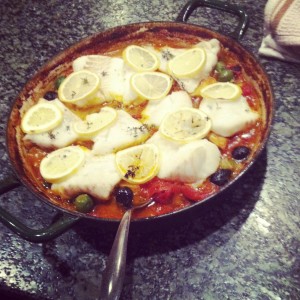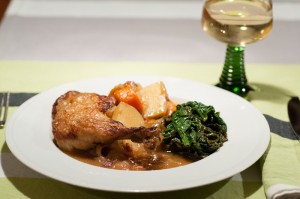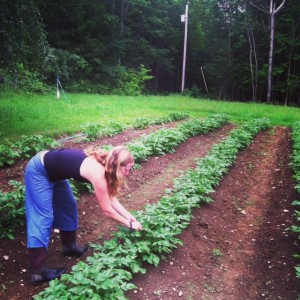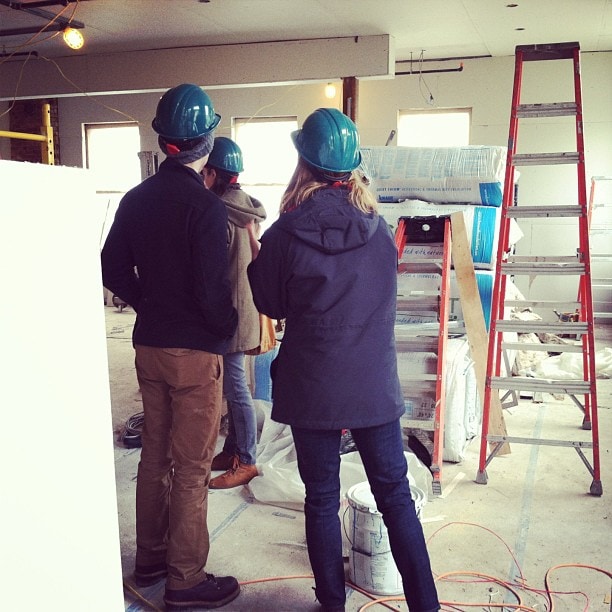Classes, SWF BLOG, Website
A Stew or a Story
med after MFK Fisher’s book “A Stew or a Story,” (a collection of short stories about food and life), we recently taught a class at Salt Water Farm focused on stewing techniques and all three of our recipes turned out divine. The first was a Coq au Vin, made with a beautiful chicken from Village Farm, a pile of mushrooms, cipillini onions and plenty of red wine. The second was a traditional beef stew, made with large cubes of locally raised beef, fingerling potatoes and rich beef stock made by our friends at Maine Meat. Lastly, we made a wonderful Mediterranean Fish Stew with salt cured olives, last-of-the-season tomatoes, lemon rounds and firm filets of cod from the Penobscot Bay. It was a delightful class and they kindly offered to help clean up afterwards. One of our very own students, Lisa Adleburg, stepped up and helped me to teach the class and it was great to see her confidence in the kitchen.
Classes, SWF BLOG, Website
Braising on the Bone with Mark and Sue Mildrum
After our Braising on the Bone class in early October, two of your students, Mark and Sue Mildrum, tackled some recipes at home. Below are photos of the beautiful meal that they put together.
SWF BLOG
A Dinner with Sandra Oliver
On the longest day of the year, we were lucky to have Sandra Oliver join us for a collaborative dinner with our head chef Justin Barrett at Salt Water Farm in Rockport Harbor. We pulled recipes from Sandy’s newest book, “Maine Home Cooking,” many of which are inspired by her column in the Bangor Daily News, entitled “Tast Buds.” She was accompanied by her partner, Tobey, who spoke to us about island culture, the summer club that they host on Islesboro together and the beautiful garden from which they pull their ingredients. The meal was historic in nature, honoring Maine’s culinary traditions. We began with a finnan haddie brandade and ployes, which are a buckwheat pancake, once used to mop up everything on the plate in earlier times. Next, we enjoyed a simply made Rockport Harbor Lobster Stew followed by a Tourtiere, made with locally raised pork, English peas, leeks & mint. We finished the meal with a rhubarb custard tart, served with elderflower cream. Sandy is Maine’s premier food historian and makes wonderful company at the table.
Classes, SWF BLOG, Website
A Visit to Dorolenna Farm
Yesterday, I drove out on Moody Mountain Road through a soft fog, admiring the lush green fileds of Lincolnville. Victoria Marshall, one the many women in our community that inspires me, operates Dorolenna Farm with her husband, Andrew and their two sons in Montville on Berry Road. They bought the place in 2007 and have incrementally built the foundation for a productive and breathtakingly beautiful farm. The property is blessed with an assortment of fruit trees: pears and apples of many varieties, a mulberry tree, a peach tree laden with fizzy fruit. In addition to their 1800’s farmhouse, they erected a barn in 2009 and a number of greenhouses that provide much need warmth for hot crops such as tomatoes, eggplants, peppers and tomatillos. They also raise meat birds, which is more Andrew’s thing. Victoria shared with me that the farm is a labor of love: it’s a chosen lifestyle that allows her family, friends and community to eat better and ultimately live better. It’s stories like these that bring warmth and richness to Mid Coast Maine.
SWF BLOG
What’s Happening at the Farm
The cooking school is underway. On Saturday, June 15th, we taught our first class, “A Celebration of Spring Greens” to eight enthusiastic students with aspiring green thumbs. We harvest a bounty of produce from our gardens and made a feast out of tender greens. Dishes included a spring greens pesto made of arugula, colt’s foot, nasturtium leaves and mustard greens, a frittata with baby kale and spears of asparagus from our garden beds, a spinach salad with sherry vinaigrette and “fork & knife” bacon and an outstanding rhubarb cake for dessert. Students left with a enriched appreciation for growing food in their own backyards and making a meal, without going to the grocery store. Oh, and I had to include a photo of my father’s very first honey harvest, not to be forgotten. Until next time . . . Annemarie
SWF BLOG
A Dinner with Kathy Gunst
We were thrilled to have Kathy Gunst join us for our first collaborative chef’s dinner on Friday, June 7th. Around our beautiful farm table, 12 guests enjoyed a procesion of spring dishes, all inspired by Kathy’s most recent book, “Notes from A Maine Kitchen.” Our head chef, Justin Barrett and Kathy collaborated on meal that was not to be forgotten consisting of a bright green lettuce soup with a poached egg, a ramp and mushroom tart with a creme fraiche crust, grilled pork form Terra Optima Farm with braised rhubarb chutney and a strawberry shortcake, made with season’s first berries. All of the food came out on big, stunning platters in generous amounts, making a feast of a meal. Kathy read a chapter from her book about hunting for ramps, the most prized of spring foraged greens and we discussed how enjoyable it is to eat in Maine in the quieter seasons. It was a wonderful start to our guest chef supper series and we thank all of those who attended and hope to see you again soon. You can buy Kathy’s book in our marketplace.
SWF BLOG
Salt Water Farm Cafe and Market – an update
We’ve spent the past couple of weeks visiting the new space-in-progess in Union Hall – taking measurements, envisioning layouts, tweaking details, and imagining the very near future. Our staff roster is complete, our menu crafted, wine and beer selections made, and market items curated.
We’re almost there, and we can’t wait to share the product of all our hard work with you.
SWF BLOG
Testing Recipes for Salt Water Farm at Union Hall
SWF BLOG
The Community Table Cookbook
By Irene Yadao
If you haven’t already picked up a copy of The Community Table Cookbook, we highly recommend it. Not only does it benefit a great cause — MCH Meals on Wheels, which delivers hundreds of meals to seniors in Knox County every day — it’s also a delightful read, featuring recipes and stories from various writers, artists, home cooks and chefs within the community.
There’s a stuffed artichoke recipe from Pulitzer Prize-winning author Richard Russo, a curry chicken recipe from mystery writer Tess Gerritsen, a recipe for Pottsfield Pickles from Nancy Harmon Jenkins, and a decadent chocolate mousse recipe from photographer Patrisha McLean, whose photographs of Meals on Wheels recipients are featured in the cookbook.
Many local establishments, including Billy’s Tavern, Swan’s Way, and Suzuki’s Sushi Bar, shared some of their favorite recipes. Salt Water Farm’s Annemarie Ahearn contributed a special lasagna recipe, accompanied by a short story recalling one of her first memories of cooking in the kitchen with her grandmother.
The book is comprised of stories both humorous and heart-warming, and celebrates the various ways we nurture each other and our community.
You can find the book locally at Rayr, The Bagel Cafe, Hello Hello Books, The Reading Corner and Sweets & Meats. It can also be purchased online at www.mchinc.org.
Photograph by Patrisha McLean courtesy of MCH Meals on Wheels.
SWF BLOG
Drawing from older tradition: Driving through Ireland, England and Italy
By Annemarie Ahearn
After three years of complete devotion to Salt Water Farm, I decided to take a trip to many of the places from which I have drawn inspiration over the past few years. Amongst them are the Ballymaloe Cookery School outside of Cork Ireland; River Cottage in Dorset, England; and Tutti a Tavola in Chianti, Italy. During the course of my travels, many of the folks sitting to my left or right asked about where I’d come from and where I was headed. “Ireland, England and Italy,” I would respond. The response was pretty much entirely one of bafflement. “What a strange itinerary,” they would say.
As many of you know, Salt Water Farm is opening a cafe and marketplace in Rockport Harbor in the spring of 2013. The intention of the trip was twofold: to draw inspiration and understanding for the road ahead, and to indulge in the cuisines and cultures of three distinctly different countries.
About two weeks before the trip, I was conducting an informal interview with the leading candidate for the head chef position at our new restaurant. He mentioned that he had wanted to visit a number of places in Europe before embarking on the project. Without hesitation, I asked him to join me in my travels and he agreed to go. And so, we spent two weeks together, always on the move, in search of culinary enlightenment.
The trip began in Dublin, which I’ve been to several times on my way into and out of Europe. I’m still not convinced that Dublin is a food destination. In fact, I’m pretty sure that its only redeeming qualities are the many drinking holes, predominantly occupied by old men and pints of Guinness. I found an establishment that suited me, took a seat at the bar and watched the evening news. Afterwards, a young and charismatic couple met me for dinner at a place called the Winding Stair, a second-story restaurant looking out over the Liffey River. The place was run by young, well-dressed cooks and waiters, and the food — sourced from the Irish country side — was really quite good.
The following day I met up with my traveling partner and we drove south through the greenest of hills towards a place called The Cow House, a working cattle farm that has been, in part, converted to an artist-in-residence program. Rosie and Frank welcomed us onto their beautiful farm and outfitted us in wellies for a walk along the winding roads of Enniscorthy. The fields were spotted with healthy cows, herds of sheep and the occasional horse. Every household was guarded by a hedge and a dog, all of whom greeted us along the way. It was wet, with a thick fog that fit snuggly over each homestead, just as I had imaged Ireland would look.
The following morning, we sped along the narrow and hedge-lined roads of Ireland (driving on the left side of the road, I might add) to the Ballymaloe Cookery School, fingers crossed that we would meet the owner, Darina Allen. She is without question my culinary idol, and so I sent along a message to the staff announcing our arrival and explaining just how much I would appreciate an introduction. The thought of meeting her in person made me quite nervous. After all, the woman has one of the largest recreational cooking schools in the world celebrating “The Lost Culinary Arts” on a 100-acre farm, as well as a series of inspiring cookbooks.
When we arrived, I sheepishly asked if I might get a chance to meet Darina and sure enough, she popped out of the office and began walking me from classroom to classroom, giving me a tour of her life’s work. Each of her sentences was interrupted by peripheral thoughts, or a student or teacher needing her attention. She was clearly so integral to the workings of the place, from the garden, to the classroom, to the cafeteria, to the administrative offices. Ballymaloe offers a 12-week class to students from around the world, teaching people how to better feed themselves and their families. The farm offers the context in which the classes thrive. Darina has also developed programs involving the local school system, making home economics a fundamental part of education in her community. After a thorough tour and an introduction to all of the students at lunch time, we were brought to a dining room where she sat us down to talk about our steps ahead. Darina has devoted her life to a business that enriches all that surrounds her. I dearly hope to follow in her footsteps.
Before leaving Ireland, we stopped at the English Market in Cork for a smoked fish pie and a stew of beef and vegetables. Both were divine, washed down by brown ale and cider.
I had never been to London before, nor had our chef. We set out to eat at some of the culinary temples of the city and to visit Borough Market. Our first stop was Fergus Henderson’s St. John Bread and Wine at Spitafield’s Market, where we ate small dishes of beef heart, pickled mackerel, rabbit and razor clams. The following day, we walked across the London Bridge to Borough Market, where meat pies, homemade English muffins, armies of English cheddar and stalls upon stalls of curry had our mouths watering. We then headed up to Islington to visit Ottolenghi, where a native Jerusalem chef produces generous platters of expertly cooked meats and vegetables, along with some of the most beautifully rustic pastries I’ve ever laid eyes on. A dear old friend, now British citizen, gave us a tour us London in the rain, including Soho, Buckingham Palace, and a cider tasting at the Harp, a place where many men have had many a drink for many years. That evening we ate at Moro, a Moorish restaurant run by a husband and wife team, where almost all of the dishes taste of the earth in some way and are either fermented or cooked in a wood fired oven. The bread at Moro rises to the level of sacred, honoring the oldest of traditions.
Never staying in one place for more than a day or two, we hopped into another tiny European car and drove, again on the left side of the road, to Devon in the English country side where we would visit River Cottage, a place that I have been envisioning for quite some time. Devon is southwest of the United Kingdom and is every bit as beautiful as it looks in the River Cottage television series. Rolling hills, heavily populated with livestock, meet the English seas and tiny towns with thatched roofs. Before our meal at River Cottage, we tucked into a pub for a pint and listened to the local dialect, which was barely recognizable to our American ears.
At six o’clock at night, we headed to River Cottage, where a covered wagon awaited 80 fairly sophisticated guests. The irony was priceless. We were greeted by a general manger of sorts in a yurt containing a wood fire and given a Calvados aperitif. We then followed a string of lights through a field to River Cottage HQ, where tables were set and a bar was stocked with locally made spirits. The chef, a measured and articulate man, explained where all of the dishes were from, how they were made and thanked us for coming. We sat beside a young couple celebrating a birthday and discussed the importance of basic culinary knowledge, which prohibits many Americans and British alike from cooking at home. In the morning we headed to a seaside town called Beer, where were introduced to an English tradition called creamed tea, which will surely find some incarnation on our menu in Rockport. It was simply a huge pot of good English tea, a cake platter piled with currant scones, clotted cream from Dorst cows and a jam of some sort. A guest shared her recipe for scones with us, which I can’t imagine would taste as good made in the United States, but we’re going to give it a try. We pocketed the leftover scones and headed to Heathrow.
Now in Rome. Never underestimate the difficulty of traveling in a country in which you do not speak the language. You are essentially rendered useless, especially during critical decision making. At midnight, standing in the taxi line at Leonardo da Vinci airport, we watched as a half dozen 70-yearold taxi drivers argued over who was going to take us “all the way to our destination,” which was four miles from the airport. When we finally got to the hotel, we asked for something to eat and the concierge brought us a bottle of wine and a tower of stale marble cake, not the Italian welcome I was hoping for. The next morning, we headed to Rome where a Bangladeshi man told us he had found us the best room in the city. Sure enough, it was looking over a charming piazza, beside a 300-year-old clock tower, with a stone balcony. You win some, you lose some.
We met our future sous chef at the Sisto bridge and he gave us a tour of the “cheaper side of Rome,” a neighborhood called Trastevere. That night we ate Roman style at a little bar where predominantly young people buy a seven euro drink which is accompanied by a generous spread of traditional Roman antipastas, such as chickpea salad, bitter greens and anchovies, and raw fennel. The following day, after touring the Pantheon, the Coliseum and parks of ruins, we met our sous chef at The American Academy, an educational institution whose heart is in an ancient courtyard, surrounded by ornate gardens, pomegranate trees, fig trees and olive trees . . . basically Eden. Alice Waters set up a culinary program in the kitchen of the University where four interns and a lead chef feed 80 fellows a buffet of traditional Italian dishes made with the finest of ingredients, twice a day. Our sous chef was one of the four interns working in the kitchen. We joined the fellows for lunch and looked down the tables at scholarly faces from around the world. For dessert, everyone had a small bowl of yogurt and seeded grapes from the vines that surrounded us. Our sous chef looked comfortable in his chef’s whites, gracious in his dealings with those having lunch at the academy and I was excited by the thought of him working in the kitchen at my new restaurant.
That evening, in Rome, I saw something I’ll never see again: starling black birds flying above the riverbank, in a tornado-like flight, and then resting in the trees that line the Tiber River. The sound they make at dusk is an orchestra of chirping that fascinates the ear. I sat on our balcony with my new chefs, and we watched as waves of blackbirds, hundreds of thousands, filled the sky in dancing processions. The three of us stared wordlessly into the darkening sky, as the birds danced for us in splashes of grey. We were in Rome, together for the first time.
That night, we ran through the rainy streets to a magnificent butcher shop that becomes a little cafe at night. When we arrived, all of the tables lining the butcher case and throughout the back of the shop were reserved, although no one was there yet. We hadn’t booked ahead, which seems to be the order of the day. After marveling at cured meats, tuna cured in olive oil, the whitest and softest mozzarella I’ve ever seen, pastas lining the wall, and bowls of olives and anchovies, I wasn’t going anywhere. The fellow at the host stand was more wide then he was tall and I thought if a blond American girl was going to get a break, this was it. I stood firmly in front of him, occasionally batting an eyelash and looking very hungry. In less than five minutes, he said “Signora,” and waved us into the back room. A spread of cured prosciutto, salamis, capicola, sopressata and an assortment of hard Italian cheeses came to the table. Beside it was a little dish of mozzarella balls, each draped in a single anchovy and dotted with bright red sun dried cherry tomatoes. Each bite — every bite — left us speechless.
The following day we headed back to the dreaded Leonardo da Vinci Airport where it took us three hours to procure a rental car, thanks to our language deficiency and frankly, a terribly inefficient system. We then headed north to Chianti to visit Mimma and Franca, the lovely Italian sisters who teach a cooking class at Salt Water Farm once a year. My fears of impossibly fast European drivers narrowly avoiding accidents was realized as cars sped around me at one hundred and eighty km/hour on the autostrada. I gripped the steering wheel of our little Fiat and prayed we’d make it there unharmed.
We stopped off in Panzano, the home of the famous butcher, Dario Cecchini, a man with hands larger than Andre the Giant. We had missed the lunch service, but as consolation, the shop had laid out rounds of Tuscan salami, seasoned lard spread on toasts, olives and few bottle of Chianti to satiate passersby. We spoke briefly with Riccardo, an assistant to Dario, who took an interest in the happenings of Salt Water Farm and a possible visit to Maine. We purchased a bit of “tonno,” which is actually braised, confited pork cut to look like tuna steaks and headed on our way.
Tuscany was everything I had imaged it to be, cyprus trees lining property divides, rows of grape vines cascading down hillsides, windy roads through ancient terra cotta towns and olive trees filling the in-between. The sun was setting as we arrived at Mimma’s home, and Franco, her husband, emerged from their stone entrance, wearing a floral ascot and a beautiful orange sweater. “Ciao bella,” he said. He held his hand to the side of my cheek adoringly and pointed at the place to park the car. It felt like we were home. That evening we ate dinner in a restaurant in a nearby village, under an ancient tower. We had ribolitta, a soup of beans, bread and vegetables and fried porcini mushrooms with a squeeze of lemon.
We woke up to a glorious fall day and toast at Mimma’s long kitchen table. In the words of Nigel Slater, “It is impossible not to love someone who makes you toast.” She gave us a loose itinerary for the day, which included a visit to a goat farm, a wine tasting at Franca’s vineyard and lunch in a little cafe that sat on a mountain top. I watched her beautiful hands as she wrote the names of villages in Italian and pointed fiercely at road intersections. We first headed to the goat farm of “La Nora,” an American woman who moved to Italy in the ’70s and was the first person in Europe to raise cashmere goats sustainably. Coincidentally, she was a high school friend of my mother’s, and even through her Italian, I could hear that Long Island accent. She wasn’t expecting our arrival and had her chores to do, so we were sent away and instructed to come back after four, when the cashmere shop opened up. Next we visited Rampini, famous for his traditional Tuscan ceramics, with hand-painted farm animals, olive branches and floral patterns, all in traditional colors of the region.
Up the road was Franca’s five acre vineyard, her home and a tasting parlor. Witnessing the results of years of hard work and care that had gone into these farms helped me to understand the value of long term commitment to a piece of property. They were purchased some decades ago for a good price and were in shambles. Mimma, Franca and Nora, along with the help of their family members, restored old animal barns into beautiful homes made of stone and brick, planted gardens of perennial herbs, vineyards and orchards, installed fencing to keep animals in or out, and created the places in which they would spend many years of their lives. Lorenzo, Franca’s son, brought us down to the cellar to show us his wine production using mostly San Giovese and Merlot grapes. They also produce a “table wine” for the family that has no label and is consumed liberally. The remnants of the production, the skins and seeds, lay in a pile in the hot Tuscan sun, ready to be made into grappa. We ate provolone and Tuscan salami, made with fennel seed and nibbled on rosemary crackers. Lorenzo lives and distributes the family’s Chianti Classico in New York City and in the past few years has expanded his market to farther-reaching American cities and other international destinations.
Franca directed us to her favorite lunch spot, nestled into a hill top, looking over the valley below. We sat in the afternoon sun, drinking a bottle of white wine, talking about our plans for the restaurant, our philosophies behind food and service and the need for Americans to take responsibility for what they consume, at home and in restaurants.
Afterwards, we coasted down the hill towards Nora’s where, as on any working farm, she was still doing chores at dusk. Despite a head full of wine, we rolled up our sleeves and helped her push an 800-pound bale of hay up a hill, which took the better part of an hour. We took multiple breaks in which we caught our breath and began the process of getting to know one another. Nora reminds me of some of the farmers I’ve met in Maine, supremely devoted to the cause, fed up with the system and despite impossible obstacles, never compromising the quality of her work. Her shop was filled with the softest of cashmere scarves, hats and shawls. They were mostly un-dyed, the natural colors of the goats’ coats: cream, light grey and charcoal grey. Their prices reflected the work and quality put into the product. Despite her strong opinions and her constant frustrations, she had a gentleness that was seen mostly in her interaction with the animals. When we left, she blew us a kiss, which truly made my day.
On our way back to Rome, and ultimately the United States, we stopped for a few hours in Sienna. I had seen many pictures of the piazza in Sienna, the magnificent clock tower and the town hall below. Standing in front of it, I felt truly humbled. How does such a place still exist in our modern world? We stumbled into a butcher shop and a charismatic butcher was plating up selections of meats and cheese on wooden cutting boards for those seeking a little lunch. I asked for a half bottle of Chianti and bit of provolone and the butcher began whacking off odds and ends of a half dozen cheeses and mounted them on a scale. About 40 Euros later, we had our mid afternoon snack. We were not the only victims of the deli assault. Groups of tourists stood throughout the shop, mouths full, slightly delirious, trying to finish wheels of cheese and piles of cured meats. Luckily there was enough wine to get through a decent amount of the fodder.
Before leaving Sienna, we hit up a gelato bar, one last little cup of Italy’s magical ice cream dessert.
The trip served so many purposes. It gave me a chance to spend time with the head chef of my future restaurant and to discuss our philosophies on food, service and the experience of eating in what will be our new home. As we drove through the countryside of Ireland, England and Italy, we learned about each other’s past experiences in kitchens and spoke of why we left the city and moved to the country. We met people all along the way, who’s devotion to their craft, whether it be a time honored recipe or the finest of cashmere, inspired us to do good, honest work on our side of the Atlantic. And most of all, we took two weeks to absorb all that was around us and reflect on its finer points in the project ahead.
All photos by Annemarie Ahearn.














































